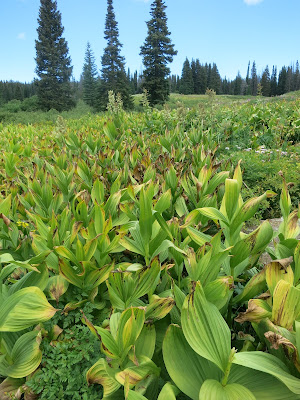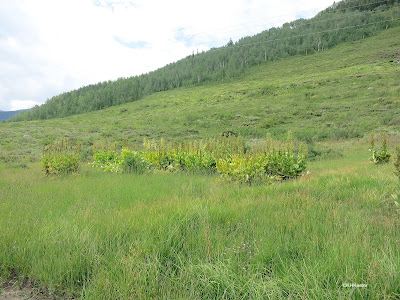California false hellebore, Veratrum californicum, is a big plant you can't miss. It is very toxic. Rising temperatures threaten it. Altogether a fascinating native American wildflower.
 |
| California false hellebore, Veratrum californicum, in the Colorado Rockies |
Veratrum is a genus of plants with leaves often reaching eight inches in length and sending up flower stalks more than six feet. Worldwide there about 20-50 species, depending on how you merge or subdivide them. For example, the Flora of North America and international plant lists like World Flora Online list five species in North America (link). USDA plants database says there are nine North American species (link).
 |
| Veratrum californicum, Colorado |
You also have a choice of common name for this plant. It is variously called false hellebore, corn lily, false skunk cabbage, just skunk cabbage (because the other skunk cabbage, Symplocarpus, does not occur in Colorado) and cow cabbage. You can add "white" or "California" or "Colorado" to those names to separate it from other species in the genus Veratrum.
Geeky botanist comments on these common names. Two common names are based on what it isn't, which is hard if you don't know the reference species. Actually, the name hellebore goes back to the Roman Empire for the European species of Veratrum, so it doesn't need to be "false." Its called false because another plant used medicinally the same way bears the scientific name Helleborus so people think of that as true hellebore (see previous blog link). But also, European settlers in the East were used to using Europe's Veratrum album (white hellebore) as an emetic and, when it ran out, shifted to American species of Veratrum, so they were "false hellebore" compared to the European medicinal Veratrum. Veratrum spreads on the ground as a clump of big leaves and smells somewhat musty, so it got named false skunk cabbage, although skunk cabbage (Symplocarpus) is an aroid, member of a quite different plant family (Araceae). Veratrum was in the lily family (Liliaceae) but today is classified in the Melanthiaceae (Trillium) family. Corn lily doesn't contain the word "false" but it refers back to two plants neither of which is very closely related Veratrum. Cow cabbage is a poor common name because it is not related to cabbage and because of the implication of eating this poisonoug plant. Maybe we should just use veratrum as a common name. I'll do that here.
 |
| Veratrum as far as the eye can see. |
If you are in its habitat, you can't miss the plant. It forms clones that can be many meters across, in low wet, high elevation areas. Representing its western affiliations, in Colorado it is more common on the Western Slope of the Rockies than on the Front Range.
Veratrum is quite toxic. All across North America, Native Americans used it as medicine, for a wide range of ailments from spreading on bruises and burns, as a disinfectant, for fevers, to clear congestion, and to produce permanent sterility. They were well aware how poisonous it is and used it carefully. It was valuable enough that tribes traveled long distances to gather it or traded it to people who lived far from its range. They, and Europeans after them, used it to kill vermin. As noted above, settlers substituted it for European hellebores. Not surprisingly, it is poisonous to livestock: animals grazing on it quickly show signs of poisoning and it causes birth defects, some of them major. Modern medicine does not use Veratrum directly because of its toxicity, but the plant's active compounds are being investigated; they effectively treat hypertension.
 |
| Veratrum californicum flowering |
Colorado veratrum grows in the Rockies near Rocky Mountain Biological Station in Gothic, CO, where D. W. Inouye has been studying the native plants since 1973, so we have long-term information on its flowering. Veratrum shows mast flowering: some years almost none of the plants flower, other years large numbers. Post doc A. M. Iler and Inouye published a study of veratrum in 2013. In the 28 years from 1984 to 2012, there was no flowering in 14 (half) of those years, a few flowers in 8 years, and, six times over 15% of the plants (max 52%) flowered. When veratrum flowers, it sends up a flower stalk that can be more than six feet tall, with thousands of small white flowers. Veratrum nectar and pollen are poisonous to some bees; the plant visited and pollinated by day by flies and at night by moths.
 |
| Mostly non-flowering Veratrum, August |
The plant stores energy for a burst of flowering. The analysis of Iler and Inouye showed that a cool July two years before had the best correlation to flowering; not water, May or June temperatures, or, curiously, extra-warm Julys. They speculate that the cooler temperatures redirect the plant from leaf growth to reproduction. A climatic cue that all the plants of the area detect is important to coordinate flowering. Mast flowering--irregular bouts of many plants flowering, between years of no flowering--most often acts to satiate seed-eating animals; so many plants flower so irregularly, that eat as many seeds as they can, the animals don't get all the seeds.
When they flower, veratrum plants also reproduces asexually, sending out rhizomes to create new shoots. The shoot that flowered, dies. Spreading in reproductive years, declining in nonflowering years, veratrum nevertheless lives over 100 years, as calculated by comparing the rate of expansion to the size of the clones.
 |
| The plant that flowers, dies. |
The climate in the Rocky Mountains has been warming steadily over the last thirty years. Some wildflowers are flowering a month earlier than in the 1970s. For veratrum, this is not a good thing. The frequency of cool Julys has decreased. Since vegetative reproduction happens at the same time as flowering, if the plantts don't get the cue to flower, they don't spread, either. The clones slowly decrease in nonflowering years. Predicting that warmer summers will cause the Rocky Mountain veratrums to decline is complicated, however, because the plant is found over a range of several thousand feet of elevation, and temperature and temperature cues vary across that. The populations of veratrum around Rocky Mountain Biological Station are so extensive that Iler and Inouye pointed out that even if they never flowered again, it would be more than 100 years before the last individual died.
 |
| Veratrum californicum, small population |
But the idea that this big dramatic plant will decline in a warming climate is a counter-intuitive result that only long-term observation and serious study could have produced. There may be many such stories among our wildflowers.
This is a native wildflower with the misfortune of being named for not being other plants. Despite being quite poisonous, it was very important medicinal plant. It flowers in dramatic bursts, but less often in our warming climate. When you are up where it grows, take a good look at it. And may take some photos so you can see for yourself in five years whether it is declining.
Comments and corrections welcome.
Related blogs: Helleborus link
The two hellebores: Veratrum and Helleborus link
References
Ackerfield, J. 2015. The Flora of Colorado. BRIT Press, Fort Worth, Texas.
False hellebore poisoning link (Accessed 4/8/23)
Hart, J. 1976. Montana Native Plants and Early Peoples. Montana Historical Society Press, Helena.
Iler, A. M. and D. W. Inouye. 2013. Effects of climate change on mast-flowering cues in a clonal montane herb, Veratrum tenuipetalum (Melanthiaceae). American Journal of Botany. 100 (3): 519-525.
Moerman, D. 1998. Native American Ethnobotany. Timber Press, Portland, OR. (online link)
Nelson, R. A. 1977. Handbook of Rocky Mountain Plants. 2nd ed. Skyland Publishers. Estes Park, Colorado.
Science Direct Veratrum link (Accessed 4/8/23)
Southwest Colorado Wildflowers See photos of fields of veratrum link (Accessed 4/8/23)
No comments:
Post a Comment